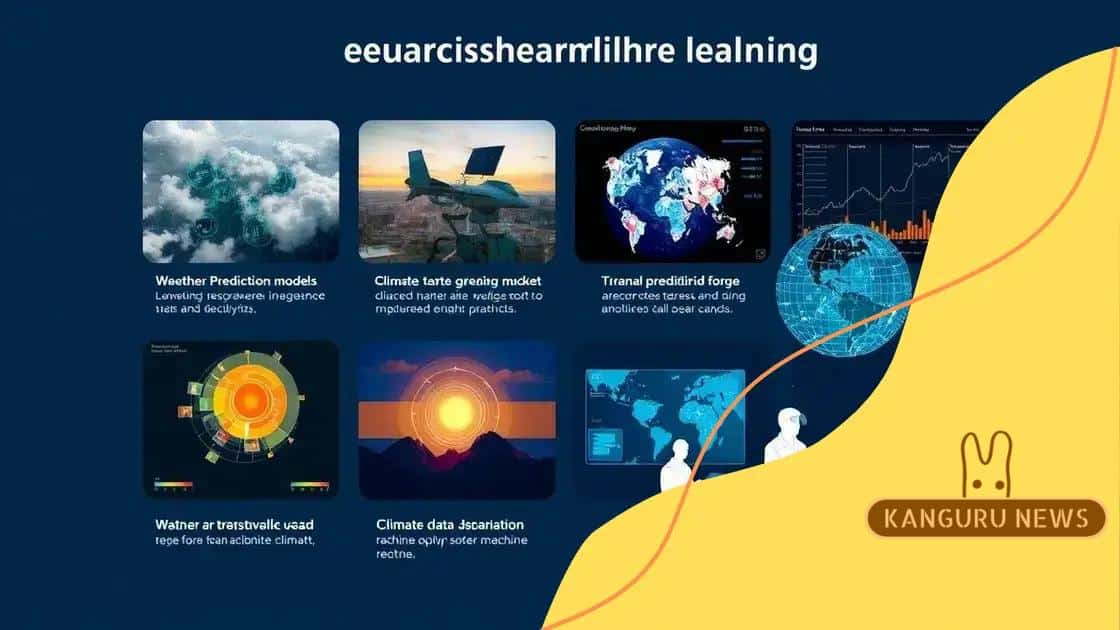How machine learning is improving climate modeling

Anúncios
Machine learning is improving climate modeling by enhancing data analysis, increasing predictive accuracy, and enabling real-time monitoring, thus providing critical insights for effective climate change management.
How machine learning is improving climate modeling plays a vital role in enhancing our grasp of climate dynamics. Imagine being able to predict climate shifts with greater accuracy. Sounds intriguing, doesn’t it? Let’s dive deeper into how these technologies are reshaping environmental science.
Anúncios
Understanding climate modeling
Understanding climate modeling is essential for predicting our planet’s future. Climate models are tools that help scientists simulate the Earth’s climate system. They analyze complex interactions between various components like the atmosphere, oceans, and land surfaces.
One important aspect of climate modeling is that it requires a great deal of data. By collecting and processing this data, researchers can create models that represent current climate conditions and forecast potential changes. These models help us understand how factors such as greenhouse gas emissions impact global temperatures.
The main components of climate models
Climate models include different elements that work together. Here are a few key parts:
Anúncios
- Atmospheric models: They simulate weather patterns and temperature changes.
- Oceanic models: These models focus on ocean currents and their effects on climate.
- Land surface models: They assess how land use and vegetation affect climate.
By combining these different elements, scientists can predict how climate might change over the coming years. These predictions are crucial for planning future actions related to climate change.
Types of climate models
There are various types of climate models, each serving different purposes.
- Weather prediction models: These focus on short-term forecasts.
- Global climate models (GCMs): They provide insights on long-term climate behavior.
- Regional climate models: These give detailed predictions for specific areas.
Each model type offers insights into different time frames and geographical areas. Understanding these models allows scientists to address key questions about our planet’s health and future.
Incorporating machine learning into climate modeling also enhances predictions. Advanced algorithms can analyze vast amounts of data, identifying patterns that traditional models might miss. This development leads to more accurate forecasts, which help policy-makers, researchers, and the public make informed decisions.
Key benefits of machine learning in climate prediction
Key benefits of machine learning in climate prediction can significantly enhance our understanding of climate dynamics. With the ability to analyze vast amounts of data, machine learning algorithms identify patterns that humans might not easily see. This capability leads to improved accuracy in forecasting climate changes.
Furthermore, machine learning tools can process data from diverse sources, such as satellites, weather stations, and ocean buoys. By integrating this information, models become more robust and trustworthy. For example, a model that combines historical weather data with current satellite observations provides better insights into future climate scenarios.
Improved accuracy
One of the major advantages is the ability to make highly accurate predictions. Machine learning techniques can refine models based on real-time data. This means the predictions often reflect the latest changes in climate rather than relying on past data alone.
- Nonlinear relationships: Machine learning excels at recognizing complex interactions in climate data.
- Adaptive learning: These systems improve over time as they learn from new data.
- Enhanced performance: Often outperforms traditional statistical methods in forecasting.
In addition to accuracy, machine learning allows for faster processing of large datasets. Traditionally, analyzing climate data takes significant time and resources. However, machine learning algorithms can quickly process and model this information, enabling timely decision-making.
Real-time predictions
The ability to provide real-time predictions is another crucial benefit. Many sectors rely on timely climate data to manage resources effectively.
- Agriculture: Farmers can receive immediate weather updates for better crop management.
- Disaster response: Local authorities can prepare for extreme weather events by receiving alerts quicker.
- Energy management: Energy companies can optimize production based on forecasted weather conditions.
As machine learning continues to evolve, its applications in climate prediction will only grow, making it a powerful tool for tackling climate change. Organizations and governments are beginning to embrace these technologies, aiming for a better understanding of our planet’s future.
Real-world applications of machine learning in climate science

Real-world applications of machine learning in climate science are transforming how researchers understand environmental changes. By utilizing advanced algorithms, scientists can analyze complex datasets that were previously difficult to manage. This provides insights that help in formulating solutions to climate issues.
Machine learning is increasingly being integrated into various fields of climate science. For instance, it assists in predicting weather patterns, assessing climate risks, and managing natural resources effectively. This is not just theoretical; significant strides have been made in this area, leading to practical applications that contribute to sustainability efforts.
Weather prediction and forecasting
One prominent application is in weather prediction. Machine learning models have improved the accuracy of forecasts significantly. By learning from historical weather data, these models can predict upcoming weather events with greater precision.
- Localized predictions: Machine learning helps in generating forecasts that are specific to small geographic areas.
- Extreme weather events: Algorithms can identify patterns leading to events like hurricanes or floods, allowing for timely warnings.
- Long-term climate outlooks: These systems can analyze data to provide insights into climate trends over years.
This capability is crucial for various sectors, including agriculture, transportation, and disaster management. Accurate weather forecasts ultimately lead to better planning and resource allocation.
Assessing climate change impacts
Another vital application is in assessing the impacts of climate change. Machine learning models analyze vast datasets to understand how climate changes affect ecosystems and human health.
- Ecosystem modeling: Researchers use these models to predict how species distribution may change in response to climate shifts.
- Health impact tracking: Algorithms can help identify trends related to climate-induced health issues.
- Resource management: Machine learning aids in optimizing the use of water and energy resources in light of changing climates.
These insights allow governments and organizations to develop informed strategies to mitigate adverse impacts and promote resilience against climate change.
As more researchers adopt machine learning in climate science, the potential for innovation expands. New applications emerge, making it an essential tool for addressing both current and future environmental challenges.
Challenges faced in integrating machine learning with climate models
Challenges faced in integrating machine learning with climate models are significant and can affect the success of climate predictions. While machine learning offers many advantages, it also comes with hurdles that researchers must overcome to achieve reliable results.
One major challenge is the availability and quality of data. Machine learning models rely on large datasets for training and validation. However, climate data can be inconsistent or incomplete due to various factors like measurement errors or gaps in data collection. This discrepancy can result in models that do not accurately reflect reality.
Data quality issues
The quality of data is crucial for machine learning effectiveness. Poor quality data can lead to biased or misleading outcomes. For instance, out-of-date or miscalibrated sensors can produce erroneous readings that skew model predictions.
- Inconsistent data sources: Different organizations may use varying methods for data collection, leading to discrepancies.
- Data granularity: High-resolution data is often required, but it may not be widely available.
- Integration difficulties: Combining data from multiple sources presents its challenges, as differences in formats and measurement standards can complicate analysis.
Additionally, the complexity of climate systems presents another challenge. Climate models involve numerous variables and interactions, making it difficult for machine learning algorithms to capture all relevant aspects. The nonlinear relationships in climate data can lead models astray if they fail to account for critical interactions.
Interpretability of the models
Another issue that arises with machine learning in climate science is interpretability. Many machine learning models, especially deep learning models, act as “black boxes.” This means understanding how they make predictions is often challenging.
- Need for transparency: Stakeholders need clear explanations of how models function to trust their outputs.
- Regulatory requirements: In some cases, regulations demand a level of interpretability that complex models cannot provide.
- Impact on decision-making: Lack of insights into model workings can hinder effective decision-making processes.
Despite these challenges, the integration of machine learning with climate models shows great potential. Addressing these obstacles can lead to better predictions and a greater understanding of climate dynamics. As research progresses, solutions to these issues are being developed, paving the way for a more robust application of machine learning in climate science.
Future trends in machine learning and climate modeling
Future trends in machine learning and climate modeling are poised to revolutionize how we understand and respond to climate change. As technology evolves, so do the methods and tools available for analyzing climate data. This presents many exciting opportunities for enhancing climate predictions and strategies.
One clear trend is the increasing use of big data analytics. The amount of climate-related data being generated is growing exponentially. By leveraging machine learning, researchers can process and analyze these large datasets faster and more efficiently than ever before. This will lead to more accurate models and predictions.
Advancements in algorithm development
Advancements in algorithms play a crucial role in shaping the future of machine learning applications in climate modeling. New techniques are being developed to improve how models learn from data.
- Deep learning: This approach enables models to learn from vast amounts of unstructured data, such as satellite imagery.
- Reinforcement learning: It allows models to make decisions based on environmental changes, improving their adaptability.
- Transfer learning: Researchers can use knowledge from one model to improve another, speeding up training processes.
These advanced algorithms can enhance predictive capabilities and help in identifying complex patterns that traditional methods might miss.
Integration with other technologies
Another significant trend is the integration of machine learning with other innovative technologies. For instance, combining machine learning with IoT (Internet of Things) devices can lead to real-time data collection from various environmental sources. This synergy can result in more dynamic and responsive climate models.
- Adaptive systems: These models can adjust to new data inputs, improving their accuracy.
- Smart sensors: They can provide ongoing monitoring of climate variables, offering timely data for analysis.
- Cloud computing: Leveraging cloud resources allows for more extensive data storage and processing power, facilitating complex computations.
The collaboration of machine learning with these technologies leads to more comprehensive understanding and prediction of climate patterns.
Furthermore, the focus on interpretability will likely increase. Scientists and stakeholders require transparency in machine learning models to trust predictions. As a result, we can expect advancements in tools that explain how models make decisions, enhancing user understanding and engagement.
In summary, the future of machine learning and climate modeling holds great promise. As tech development continues, we can anticipate a more profound impact on both climate science and practical applications in managing climate challenges.
FAQ – Frequently Asked Questions about Machine Learning in Climate Modeling
How does machine learning improve climate predictions?
Machine learning enhances climate predictions by analyzing vast datasets quickly and identifying complex patterns that traditional methods might miss.
What are the benefits of using machine learning in climate science?
Benefits include improved accuracy, real-time data processing, and the ability to adapt to new information, leading to better climate management.
What challenges are faced in integrating machine learning with climate models?
Challenges include data quality issues, the complexity of climate systems, and the need for model interpretability.
What are the future trends in machine learning for climate modeling?
Future trends include advancements in algorithms, integration with IoT technologies, and increased focus on enhancing model interpretability.





